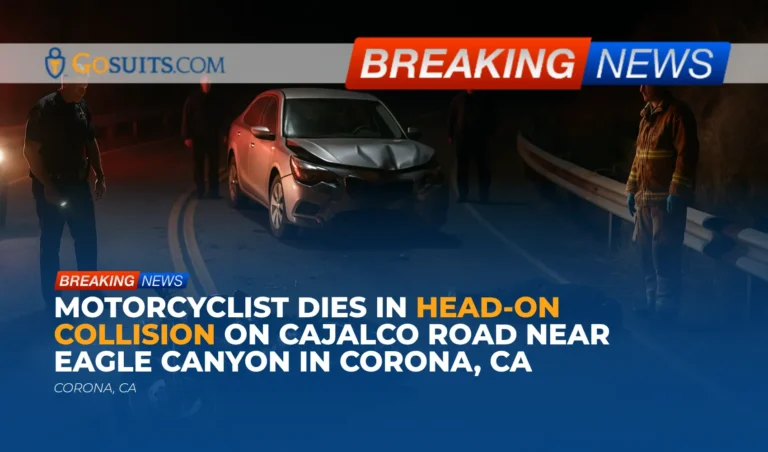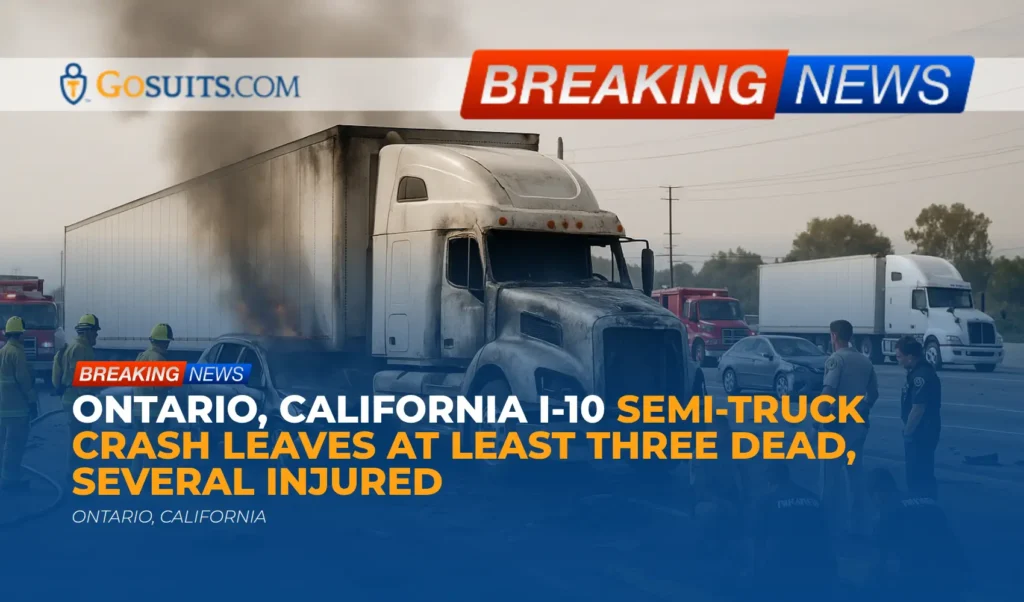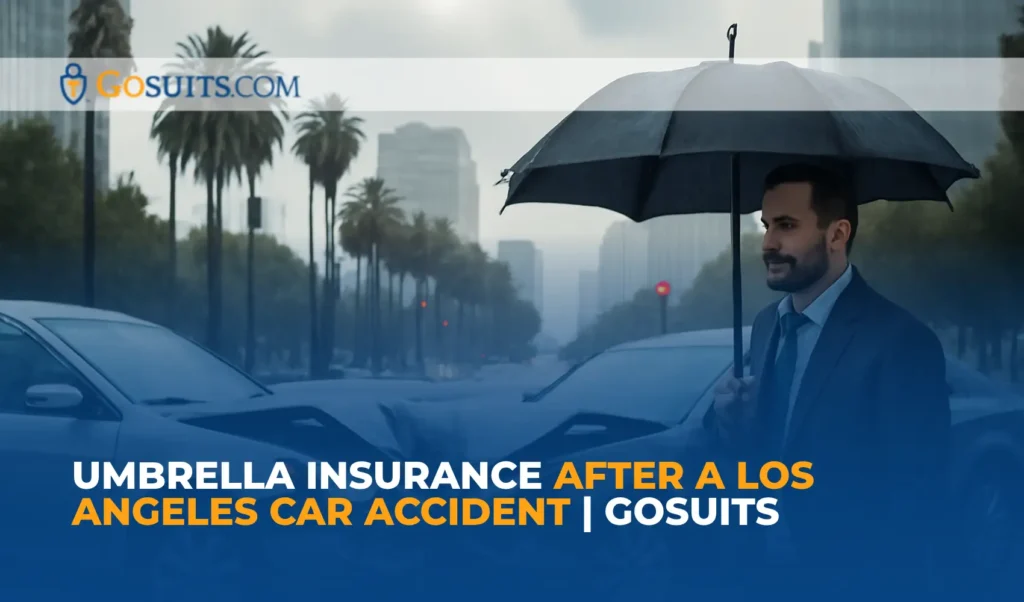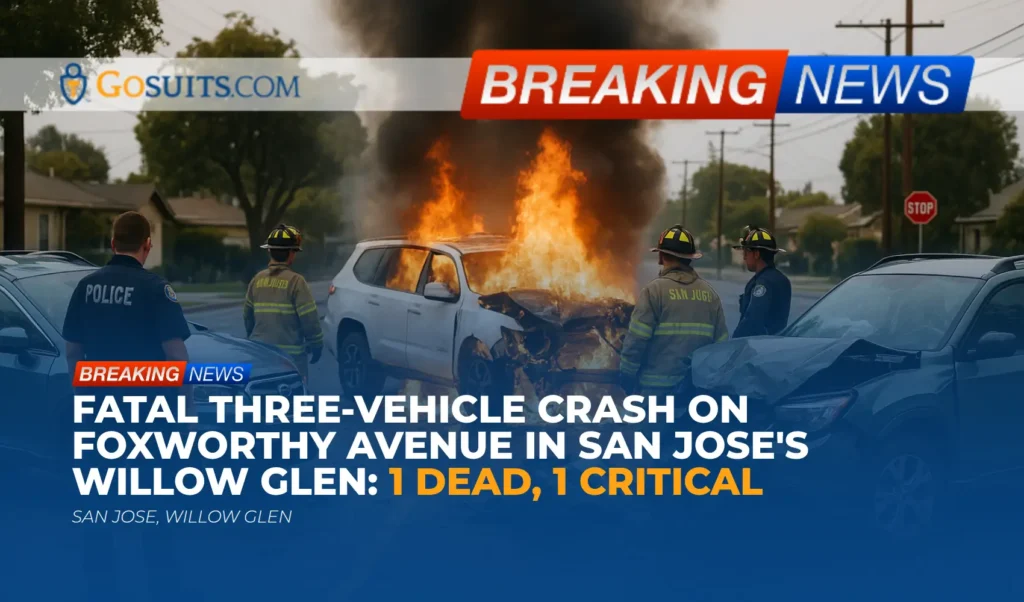- What is known about the Corona head-on motorcycle and car collision
- Information shared by responding agencies and what remains under investigation
- Why head-on crashes increase on sharp curves at night
- Civil liability questions that often arise in head-on car vs motorcycle crashes in California
- Evidence that can shape fault findings in a head-on collision
- How to obtain official records: police report, autopsy, and vital records
- Insurance considerations after a fatal motorcycle collision
- Rights of surviving family members under California law
- Roadway design and potential public entity issues on sharp curves
- Community safety reminders for curved roadways and motorcycles
- Practical first steps families often consider in the days and weeks after
- Agencies and offices that can provide information or records
- Commentary from Gosuits Corona, California Personal Injury Attorney
- Why acting promptly matters after a serious or fatal crash
What is known about the Corona head-on motorcycle and car collision
Initial reports indicate that on 10-19-25 at approximately 8:45 p.m., a car and a motorcycle collided head-on on Cajalco Road near Eagle Canyon in Corona. First responders from the California Highway Patrol’s Riverside office, Corona Police Department, and Corona Fire Department arrived to find a car with moderate front-end damage and a motorcycle down in the roadway. Paramedics located the motorcyclist over the roadside railing, and the rider was pronounced deceased at the scene. Occupants of the car remained on-site, were evaluated by paramedics, declined transport, and cooperated with law enforcement. Officers at the scene noted that both vehicles were reportedly traveling around 40 mph in opposite directions around a sharp turn when the collision occurred. A .22 caliber firearm was reportedly located at the scene, though ownership was unclear at the time of reporting. Both vehicles were taken as evidence. It was not yet known whether alcohol or drugs were involved, and the collision remained under investigation (referenced by CHP CAD Log incident number 0752).
Because this is an active investigation, final determinations about cause and fault have not been released publicly. Families and community members should expect additional updates after collision reconstruction work, witness interviews, and laboratory testing are completed.
Information shared by responding agencies and what remains under investigation
The information shared by officers at the scene provides important early context, but many crucial findings typically come later:
- Scene documentation and measurements: Investigators usually document vehicle resting positions, impact angles, skid or yaw marks, roadway geometry, lighting, and sightlines. Later analysis can help determine whether either vehicle crossed the center line, traveled too fast for the curve, or failed to maintain a lane.
- Witness statements: Statements from occupants, nearby drivers, and residents can establish pre-impact behavior such as lane position, use of headlights, sudden swerves, or braking.
- Toxicology and medical findings: Autopsy and toxicology results may inform timelines and physical mechanisms of injury. These are handled by the county’s coroner’s office. Results typically take weeks.
- Vehicle inspections: Law enforcement and forensic specialists examine brakes, tires, steering, lights, and potential mechanical failure. Modern vehicles often contain electronic data that can shed light on speed and braking prior to impact.
- External factors: Investigators look at environmental conditions, roadway signage, pavement condition, debris, and visibility on the curve at night.
What remains unknown from initial reports includes the precise lane positions at impact, whether any vehicle violated a traffic law, how visibility and the curve geometry contributed, whether impairment or distraction played a role, and whether the found firearm had any connection to the events leading to the crash. It is not appropriate to speculate on these points until the official findings are available.
Why head-on crashes increase on sharp curves at night
Sharp curves narrow driver margins for error. At night, reduced visibility, glare, and limited sight distance compound risks. The basic speed law in California requires that drivers never travel faster than is reasonable or prudent given actual and potential hazards, including curves and visibility, even if driving at or below the posted limit. See California Vehicle Code section 22350 at leginfo.legislature.ca.gov.
National roadway safety research underscores that horizontal curves are overrepresented in severe crashes. The Federal Highway Administration discusses strategies to mitigate curve-related crashes, such as improved signage, chevrons, and advisory speeds, at safety.fhwa.dot.gov. When a motorcyclist meets an oncoming vehicle on a curve, any small encroachment across the center line, a misjudged entry speed, or a late correction can produce a head-on conflict with devastating consequences given the motorcyclist’s vulnerability.
Motorcyclists face significantly higher risks of severe injury or death in collisions. The National Highway Traffic Safety Administration provides data and safety guidance at nhtsa.gov. Among the themes emphasized are visibility, lane positioning through curves, speed control, and anticipating opposing traffic near the center line.
Civil liability questions that often arise in head-on car vs motorcycle crashes in California
Every collision is unique, but investigators and insurers commonly assess several civil liability questions in head-on crashes on curves:
- Lane position and centerline compliance: Was either vehicle partially or fully left of center at impact? Even slight encroachment on a sharp curve can create a head-on trajectory.
- Speed too fast for conditions: Under the basic speed law, even lawful speeds may be unsafe if road curvature, darkness, or limited sight distance require lower speeds. See California Vehicle Code section 22350 at leginfo.legislature.ca.gov.
- Lighting and visibility: Proper headlight use, high vs low beams, and the presence of roadway lighting can influence reaction time and lane-keeping on curves.
- Roadway design or maintenance: In rare cases, absent or inadequate warning signs, worn markings, or surface defects may contribute. Potential public entity liability has distinct procedures and deadlines discussed below.
- Protective equipment: California requires all motorcycle riders and passengers to wear helmets meeting federal standards. See California Vehicle Code section 27803 at leginfo.legislature.ca.gov. Helmet compliance and equipment condition can factor into injury analyses, though primary fault usually turns on vehicle operation.
California follows the principle that everyone is responsible for injuries caused by a failure to use ordinary care. See California Civil Code section 1714 at leginfo.legislature.ca.gov. California also uses a comparative fault framework, meaning responsibility can be shared among involved parties in proportions that reflect their contribution to the crash. Allocation depends on the evidence and is often contested by insurers.
Evidence that can shape fault findings in a head-on collision
Key evidence categories commonly evaluated in serious head-on collisions include:
- Traffic Collision Report and scene diagrams: The CHP report typically includes mapped points of impact, measured marks, roadway geometry, and preliminary findings.
- Electronic Data Recorders (EDRs): Many passenger vehicles contain EDRs that can capture pre-impact speed, brake application, and steering inputs. The National Highway Traffic Safety Administration provides details about EDRs at nhtsa.gov.
- Physical evidence from vehicles: Crush patterns, paint transfer, and fluid trails can corroborate impact orientation and lane position.
- Environmental and roadway evidence: Tire marks, gouges, debris fields, and the location of the first area of impact can be decisive in a head-on scenario.
- Witness and occupant statements: Timely statements can preserve details about pre-impact movement, speed, and lane position, especially on a dark, sharp curve.
- Medical and toxicology reports: These can clarify time of death, mechanisms of injury, and whether impairment may have been a factor. Toxicology results typically take several weeks.
- Firearm found at the scene: When an unrelated item is found at a crash site, investigators document chain of custody and potential relevance. Unless linked to pre-crash behavior or distraction, it may have no bearing on civil fault, but investigation will clarify.
How to obtain official records: police report, autopsy, and vital records
Families and involved parties often need official documents to understand what happened and to handle practical matters. Here is how those requests typically work in California:
CHP Traffic Collision Report
For crashes investigated by CHP, collision reports are requested using the CHP 190 process. The agency provides instructions at chp.ca.gov. Reports generally become available after the investigating officer completes the document and supervisory review. You will typically need the date, time, location, and if available, the CHP incident number (here, CAD Log 0752) and names of involved parties to request the report.
Coroner records (autopsy and cause of death)
Autopsies, if performed, and cause-of-death determinations are handled by the county’s sheriff-coroner. Timelines for reports vary and can extend several weeks, especially if toxicology is pending. While each county has its own procedures, the California Department of Public Health provides general information about vital records processes at cdph.ca.gov. Families can contact the county sheriff-coroner’s office for specific steps to request reports. When making a request, have the decedent’s name, date of death, and location of incident available.
Death certificates
Death certificates are essential for estate matters and certain claims. They can be requested through the county clerk-recorder or via the California Department of Public Health’s Vital Records unit. See cdph.ca.gov for statewide guidance and forms.

Supplemental records
- Photographs and diagrams from law enforcement may be available upon request when the investigation closes.
- 911 audio and dispatch CAD logs may be disclosable depending on agency policies and whether release could compromise an active investigation.
- Tow yard chain-of-custody and vehicle inspection records can help track evidence integrity.
Insurance considerations after a fatal motorcycle collision
Insurance issues in a head-on car versus motorcycle collision can be complex, particularly when fault is disputed or shared. Some general considerations in California include:
- Liability coverage of the at-fault driver: Bodily injury liability coverage is intended to compensate others for harm caused by the insured driver’s negligence. If comparative fault is alleged, insurers often try to reduce payouts proportionally.
- Uninsured/Underinsured Motorist (UM/UIM): If the at-fault driver has inadequate coverage, the motorcyclist’s own UM/UIM policy, if any, may apply, particularly in wrongful death claims brought by eligible family members.
- Medical payments coverage: Some motorcycle policies include limited medical payments coverage regardless of fault, which can help with immediate expenses.
- Property damage: Claims for the motorcycle and gear typically proceed alongside bodily injury or wrongful death claims.
Important caution: Before contacting any insurance company to give a statement, it is prudent to speak with a qualified attorney for a free consultation. Statements made to insurers can be recorded and may be used to limit or contest a claim later. Insurers may request broad medical or phone authorizations; it is wise to understand rights and potential implications before signing anything.
Rights of surviving family members under California law
When a death results from a wrongful act or negligence, California law provides two distinct civil actions that may be available to families and the decedent’s estate:
- Wrongful death claim: This claim belongs to certain surviving family members and seeks compensation for their losses, such as loss of financial support and companionship. Eligibility is defined by statute. See Code of Civil Procedure section 377.60 at leginfo.legislature.ca.gov.
- Survival action: Brought by the decedent’s personal representative or successor in interest to recover certain losses the decedent sustained before death. See Code of Civil Procedure section 377.30 at leginfo.legislature.ca.gov.
Deadlines: Most wrongful death and personal injury claims in California must be filed within two years of the injury or death. See Code of Civil Procedure section 335.1 at leginfo.legislature.ca.gov. Different, shorter deadlines apply if a public entity may be involved. Claims against public entities generally must be presented within six months. See Government Code section 911.2 at leginfo.legislature.ca.gov.
Legal standards: California’s general negligence principle holds each person responsible for injuries occasioned by a lack of ordinary care in the management of person or property. See Civil Code section 1714 at leginfo.legislature.ca.gov. In practice, this requires careful evidence gathering and analysis to determine how and why the collision occurred.
Roadway design and potential public entity issues on sharp curves
Sometimes serious crashes on curves raise questions about roadway design or maintenance, such as whether advisory speed signs, chevrons, or centerline markings were adequate. The Federal Highway Administration provides information about countermeasures that reduce curve-related crashes at safety.fhwa.dot.gov. If a claim involves a public entity’s role in road design or maintenance, special procedures apply and deadlines are much shorter. In California, a written claim to the appropriate public entity generally must be presented within six months under Government Code section 911.2, available at leginfo.legislature.ca.gov.
Public entity matters are technically complex. Whether a roadway condition contributed to a crash requires qualified engineering analysis and comparison to applicable standards and practices. Families sometimes preserve roadway evidence by documenting signage, markings, and visibility as soon as possible after the event.
Community safety reminders for curved roadways and motorcycles
While investigators determine the facts in this case, shared safety practices can reduce future tragedies:
- Approach sharp curves conservatively at night: Reduce speed and avoid cutting corners, especially on undivided two-lane roads where oncoming traffic may be near the center line. California’s basic speed law applies even below posted limits on hazardous curves. See Vehicle Code section 22350 at leginfo.legislature.ca.gov.
- Lane discipline on curves: Hold a line well within the lane to preserve margin from the center line. Drifting across the center on a blind curve is a common precursor to head-ons.
- For motorcyclists: Use a smooth, outside-inside-outside line only within your lane, set entry speed early, and look through the curve. Always wear a compliant helmet per Vehicle Code section 27803 at leginfo.legislature.ca.gov. NHTSA’s motorcycle safety guidance is at nhtsa.gov.
- Vehicle readiness: Proper tire pressure, suspension, and lights are especially important for maintaining grip and visibility on curves at night.
- Expect the unexpected: On rural or semi-rural roads, anticipate debris, gravel, or animals near curve apexes.
Practical first steps families often consider in the days and weeks after
After a sudden fatal crash, families may be balancing grief with urgent tasks. The following actions are general, practical steps often taken to protect information and options:
- Preserve personal evidence: Secure the rider’s helmet, clothing, phone, and any camera or GPS devices. Do not repair or dispose of the motorcycle without guidance, as it may hold crucial evidence.
- Document the roadway: If safe and feasible, photograph the curve, signage, markings, and lighting conditions at the same time of night with similar lighting. Capture centerline visibility and any obstructions.
- Identify witnesses: Collect names and contact information for anyone who saw the crash or the vehicles shortly beforehand.
- Request official records: Start the process for the CHP collision report through chp.ca.gov. Contact the county sheriff-coroner for autopsy and cause-of-death procedures. For death certificates, see the California Department of Public Health at cdph.ca.gov.
- Review insurance policies: Locate the motorcyclist’s and household members’ auto or motorcycle policies for possible UM/UIM coverage. Before giving any recorded statements to insurers, first consult an attorney.
- Mind the timelines: Two years is the general limit for wrongful death in California, but some claims, including those involving public entities, can have much shorter deadlines. See Code of Civil Procedure section 335.1 and Government Code section 911.2 at leginfo.legislature.ca.gov.
These steps are intended as general information to help families understand the process. Each situation is unique, and decisions should be made with careful consideration and, when appropriate, legal guidance.
Agencies and offices that can provide information or records
Based on the initial report, the following offices are relevant to this incident in the Corona area:
- California Highway Patrol, Riverside area: Primary collision investigation and report. Request reports using instructions at chp.ca.gov.
- Corona Police Department: Assisted at the scene. For non-emergency inquiries, consult the city’s official website for contact details.
- Corona Fire Department: Responded for emergency medical care; medical records at the scene are limited, but times and actions may appear in the collision report.
- County Sheriff-Coroner: Autopsy, cause-of-death, and release procedures. Each county has specific request steps; general state-level vital records guidance is available at cdph.ca.gov.
When contacting agencies, have the date, approximate time, location, and any incident number available, along with identification to confirm your relationship to the involved party.

Commentary from Gosuits Corona, California Personal Injury Attorney
Our hearts are with the family and friends mourning the rider who lost their life on Cajalco Road. Sudden loss on a familiar roadway is devastating, and we recognize how painful it is to seek answers while grieving. This discussion is offered for educational purposes and general information about the civil process that often follows a serious crash.
In our view, head-on collisions on sharp curves at night highlight how narrow the safety margins can be for everyone, and especially for motorcyclists. The facts that will matter most in the civil context are lane position, speed choices relative to the curve and visibility, the geometry and markings of the roadway, and any mechanical or environmental contributors. Findings from the CHP reconstruction, physical evidence on both vehicles, and the mapping of the impact area frequently resolve contested narratives about which vehicle crossed the center line or whether speeds were too high for the curve.
Insurance companies and large corporate actors are skilled at protecting their financial interests. They often move quickly to collect statements, secure vehicle data, and frame fault arguments. Without guidance, families can unknowingly say things in recorded statements or sign broad authorizations that later undermine their claims. Even seemingly simple questions about speed estimates or lane position can have outsized effects if taken out of context. That is why understanding the process and the rules of evidence early can make a meaningful difference in how a claim unfolds.
Obtaining a free consultation promptly can help people understand timelines, evidence preservation, and potential sources of recovery, including UM/UIM coverage and potential public entity issues if the roadway may have contributed. A conversation that clarifies rights and obligations before speaking with any insurer can reduce the risk of missteps and allow families to focus on what matters most.
Why acting promptly matters after a serious or fatal crash
The period after a catastrophic crash is overwhelming, but certain steps are time-sensitive and can protect critical information and options:
- Evidence changes quickly: Skid marks fade, debris gets cleared, vehicles are repaired or salvaged, and roadside vegetation changes. Acting sooner allows documentation of the curve, signage, and lane markings as they existed at the time of the collision.
- Electronic data can be overwritten: Vehicle Event Data Recorders may overwrite with subsequent operation or lose power over time. Securing vehicles and arranging preservation requests early increases the odds of retrieving useful data. See NHTSA’s EDR resource at nhtsa.gov.
- Deadlines can be short: California’s two-year statute for wrongful death (Code Civ. Proc. 335.1) is a ceiling, not a target. If a public entity may be involved due to roadway conditions, administrative claims often must be filed within six months (Gov. Code 911.2). See leginfo.legislature.ca.gov.
- Insurance tactics begin early: Insurers may request recorded statements and broad authorizations soon after the crash. Speaking with an attorney first helps ensure that what is shared is accurate, complete, and not used unfairly later. What someone says to an insurer can be used against them.
- Financial planning and benefits: Death certificates and coroner determinations are needed for employment benefits, life insurance, and other administrative steps. Beginning requests early can ease later burdens. State-level guidance on vital records is at cdph.ca.gov.
Taking organized, timely steps preserves choices, helps clarify what happened, and supports informed decisions about the path forward.






